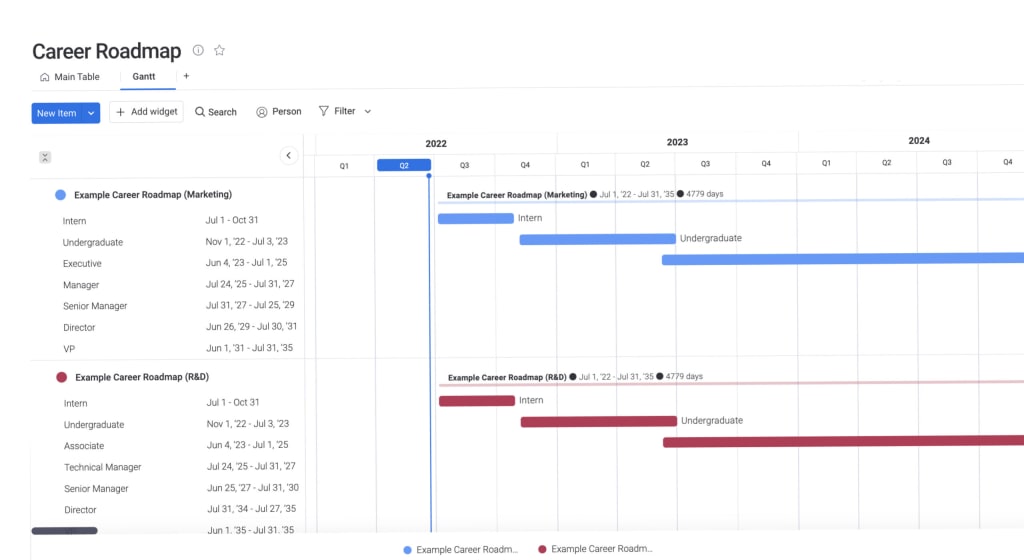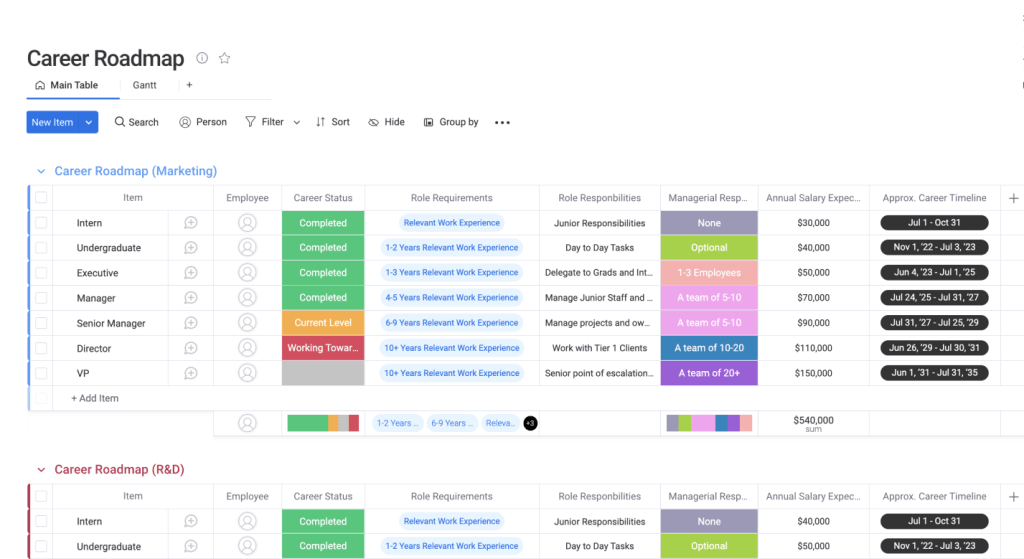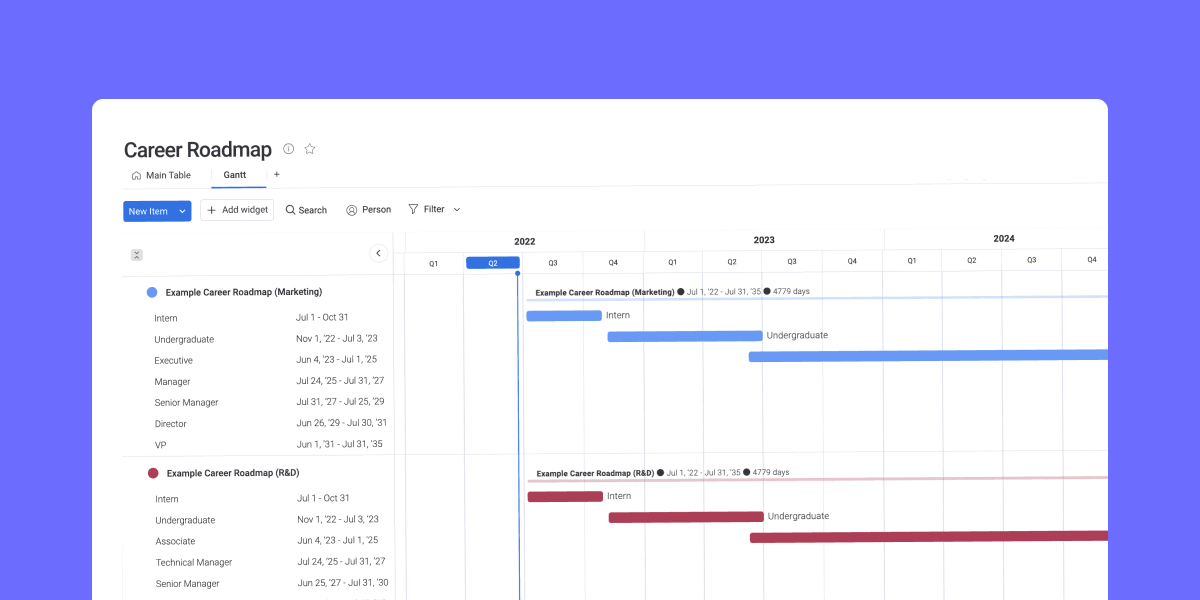In a market where more than 72% of employees state that clear development opportunities are important to them offering clear pathways for growth increases your ability to recruit and retain valuable employees.
A career roadmap template helps you outline custom charts for each employee’s career goals, supporting transparency and providing evident pathways for potential career movement.
This article covers how to use one as a tool for your HR team and employees so you can reflect a culture of integrity and commitment. You’ll also get access to monday.com’s customizable career roadmap template below.
What is a career roadmap template?
A career roadmap template is a customizable, predesigned plan that helps you create individualized career roadmaps for team members.
Using a career roadmap template lets you account for relevant departments, roles, descriptions, and requirements to chart an employee’s path for ongoing success.
For example, you can describe a marketing coordinator’s role as the marketing department’s go-to person for data, projects, and industry updates. You can then map the marketing coordinator’s goals for specific timeframes, such as handling pay-per-click budgets by the end of Q2 and writing marketing copy by year-end.
Why use a career roadmap template?
Career path templates make your job easier by allowing you to skip the design and format steps each time you start a career roadmap, supporting efficiency and allowing you to spend more time on your staff member’s goals.
Starting with a career roadmap template lets you focus on your employee’s development. With a career roadmap template, you can:
- Account for career movement across —and outside — your organization: Visualize employee career movement goals, including vertical growth, lateral movement across departments or organizations, and more.
- Provide employees with actionable steps to achieve their goals: Organizational movement becomes more transparent. Including job descriptions and requirements allows employees to determine what skills they might need to develop in order to move on in their career journey.
- Adapt an employee’s career roadmap as their goals change: Life circumstances, new experiences, perspectives, and opportunities can all affect an employee’s desired career movement. You can edit your career roadmap templates, so they’re responsive to your employee’s needs and desires.
Now that we’ve covered what a career roadmap template is, let’s get into some different types of career roadmap templates. Keep in mind that all career maps should include:
- Desired job descriptions and titles
- Desired job qualification requirements
- Desired job pay ranges
What are some examples of a career roadmap template?

Career progression may not follow a linear path. Some people want to climb the corporate ladder to the top — others may want to find a comfortable career perch and stop. Career planning tools that account for all types of career growth and movement are important.
Vertical
When thinking about a career path, “up the ladder” movement is often the first thing to come to mind. In this traditional model, an employee is hired and promoted over time as they gain relevant skills and experience they can add like badges to resumes and professional social media profiles. Templates that support this model work for employees with goals to grow upward in level and responsibility.
ateral
Interest in lateral movement occurs when employees want to broaden their range of skills across different functions, want to be challenged but don’t have access to current opportunities for vertical growth where they are, or discover they want to work in a different department or organization altogether. For example, a junior copywriter at an ad agency might take on a new role as a social media manager but not change their level of seniority.
Demotion
Occasionally, employees may intentionally step down from a role or pay status for personal reasons. They may not be enjoying their newfound responsibilities or simply prefer to move to an area they’re more passionate about, but less experienced in. Whatever the reason, supporting employees to take this nontraditional can increase your retention and employee satisfaction. Templates that allow such options lay an actionable pathway for meeting career goals that don’t include promotion.
Understanding the direction your team members want to move in their careers can help you develop effective plans with actional steps to ensure your employee’s career satisfaction.monday.com offers a free career roadmap template that lets you account for any kind of career movement.
monday.com’s free career roadmap template
monday.com’s career roadmap template lets you efficiently produce an attractive, customized document to make desirable career movements visible to your employees. Our template helps you map out pathways no matter what direction team members would like to move. With monday.com’s free career roadmap, you can:
- Segment your roadmaps by department
- House each role’s job salary, description, and responsibilities, including management duties
- Track each team member’s tenure and goals by month, quarter, or year
- Color-code goals, timelines, and more for better visibility
- View your roadmaps in Gantt chart or list view

On top of that, you can use a variety of templates with monday.com’s Work OS that leverage transparency to keep your team engaged and on target. monday.com offers customizable solutions for every industry, allowing you to manage your entire workflow including project management and employee accountability.
Related templates to the career roadmap template
Like the idea of helping employees plan for now and the future by starting with customizable templates? Try some of our other templates.
Work plan template
Similar to a career roadmap, a work plan should provide a clear, outlined approach to moving through a project or task. Well-developed work plans let your team take ownership of their objectives and collaborate effectively with a shared blueprint in mind. Developing your work plan involves understanding your goals and the broad strategy required to achieve them. Our Work Plan Template is an intuitive tool that lets you and your teams articulate the necessary steps to achieve desired outcomes.
Work from home plan template
Working from home (WFH) is the new normal for many people, and WFH software helps you ensure transparency and effective use of technology to support overall success with this model. Our WFH Work Plan Template is an easy-to-customize tool that helps you plan projects, assign ownership, and keep an eye on KPIs — no matter where your teams are working.
Career roadmap templates and other tools help you boost success for your teams. But understanding more about what a strong career plan looks like helps you put these tools to best use.
FAQs about career roadmap templates
What are the eight steps to making a career plan?
Making a career plan is a great start for employees that are co-creating their career roadmaps. There are eight steps to creating a career plan:
- Begin a process of self-reflection: Use a self-assessment tool to determine skills and experience you can contribute. Think about your passions and other desires you might have, such as earnings potential and work culture.
- Identify career options: Research careers to get a sense of the positions that best match what you uncovered in your self-reflection.
- Filter career options against goals and needs: Remove careers that don’t meet your goals, needs, and interests and prioritize those that do.
- Consider job qualifications: Research the qualifications necessary for the roles you’re interested in. This might include experience, education, and character traits. Consider which careers may be more or less difficult to pursue based on your current resume.
- Understand potential career roadmaps: Ask your current employer what path they can provide to help you achieve your goals.
- Choose a career to pursue: Choose a path and stick with it to increase your chances of success.
- Create SMART goals: Whether you’re putting in applications and working to ace the interview or pursuing further education, using the SMART goal model makes success more likely.
- Create your career action plan: Use your SMART goals to determine what actions to take to get where you want in your career.
What is a typical career path?
While the traditional career model was conceived with the progressive promotion in responsibility and pay in mind, there is no best-fits typical career path for a given individual. Intention and accountability are what separates a job from a career. The typical career path involves planning and change, whether you’re moving into new skill areas, increasing responsibility, or making an intentional shift to meet your personal needs. Career paths are often adaptable to external factors such as market changes as well as changes in personal priorities.
Support employees’ job development with a career roadmap
Hiring great candidates and keeping them in your organization is easier when you provide them with clear pathways for career development. Career roadmap templates let you work with your employees to create custom charts that align with your organization and their career plans.
monday.com’s intuitive career roadmap template lets you build custom career paths that support morale, growth, and success.
